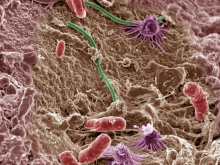
Soil microbes may not be as adaptable to climate change as expected, according to new research published in the journal PLOS One. The study raises concerns that the tiny bacteria, fungi and other micro-organisms that determine soil health and exert enormous influence over the earth’s carbon cycle might struggle to carry out essential ecosystem functions under changing conditions. “Soil is the major buffer system for environmental changes, and the microbial community is the basis for that resilience. If the microbial community is not as resilient as we had assumed, then it calls into question the resilience of the overall environment to climate change,” said one of the authors, Vanessa Bailey of the U.S. Department of Energy’s Pacific Northwest National Laboratory. In a long-term study, the researchers exchanged soils samples from two differents sites on the same mountain slope in eastern Washington state which both have similar plant species and soil types. The higher location had a cooler, moister climate and 500 metres down the mountainside the climate was warmer and drier. After 17 years, they analysed soil samples in the laboratory as well as control samples from both locations, measuring CO2 production, temperature response, enzyme activity, and bacterial community structure. The scientists found that the microbes in both sets of transplanted soils retained many of the characteristics they had in their “native” climate, including their original rate of respiration – how quickly microbes convert carbon in the soil into carbon dioxide as they break down organic matter. The microbes native to the higher site naturally respire at a higher rate because of the moister climate and larger supplies of carbon in their environment. When they were moved down to the warmer site, they continued to respire at a fast rate other than their colleagues from the lower location. The microbes that were moved up the mountain showed an unusually small response to the temperature change and continued to respire at a slow rate although biological theory and climate models predict a larger change. According to the authors, it is surprising to find that the soils’ native environment continued to exert such a profound influence on microbial activity even 17 years later. This means that we can’t just assume that soils will respond to climate changes in the ways that many scientific models predict, the authors conclude. (ab)
